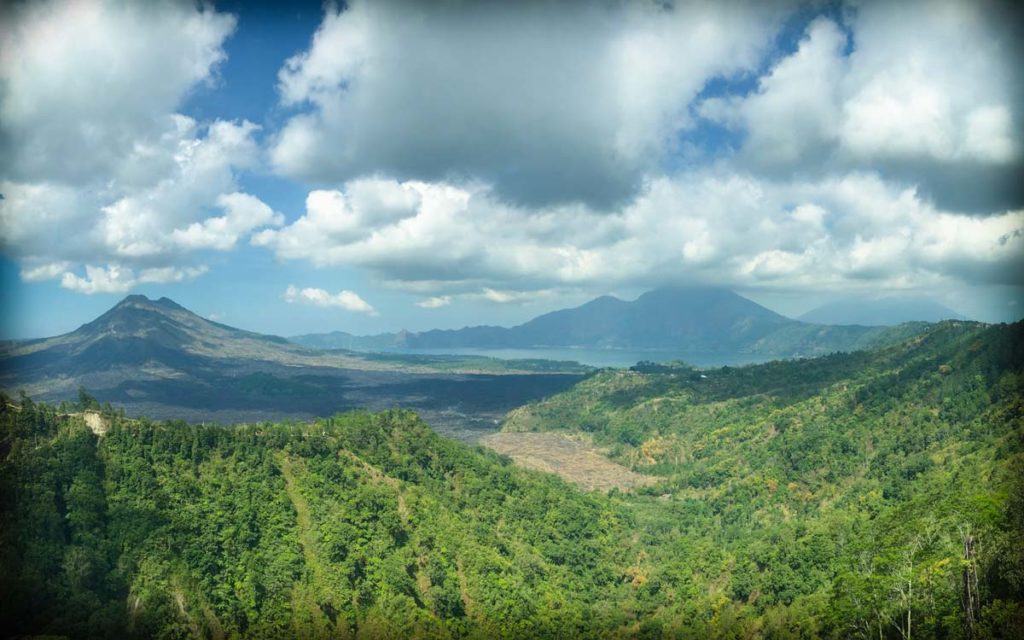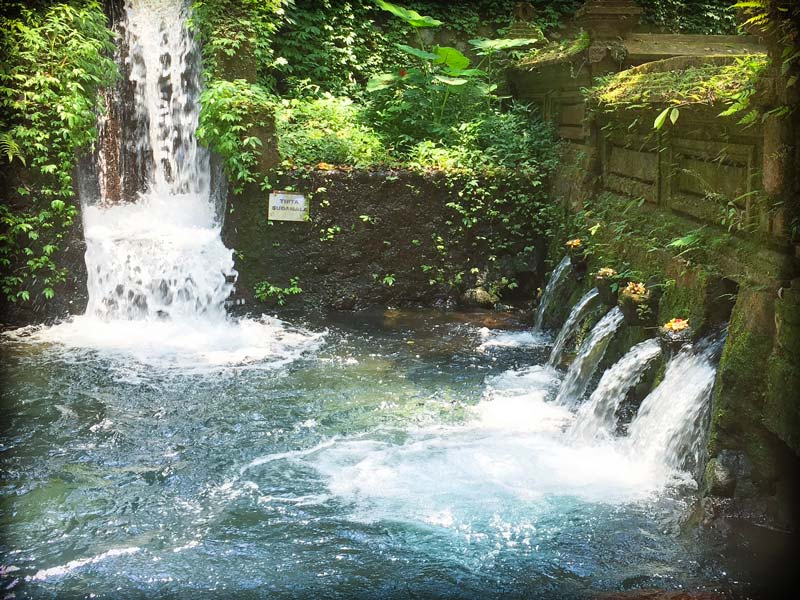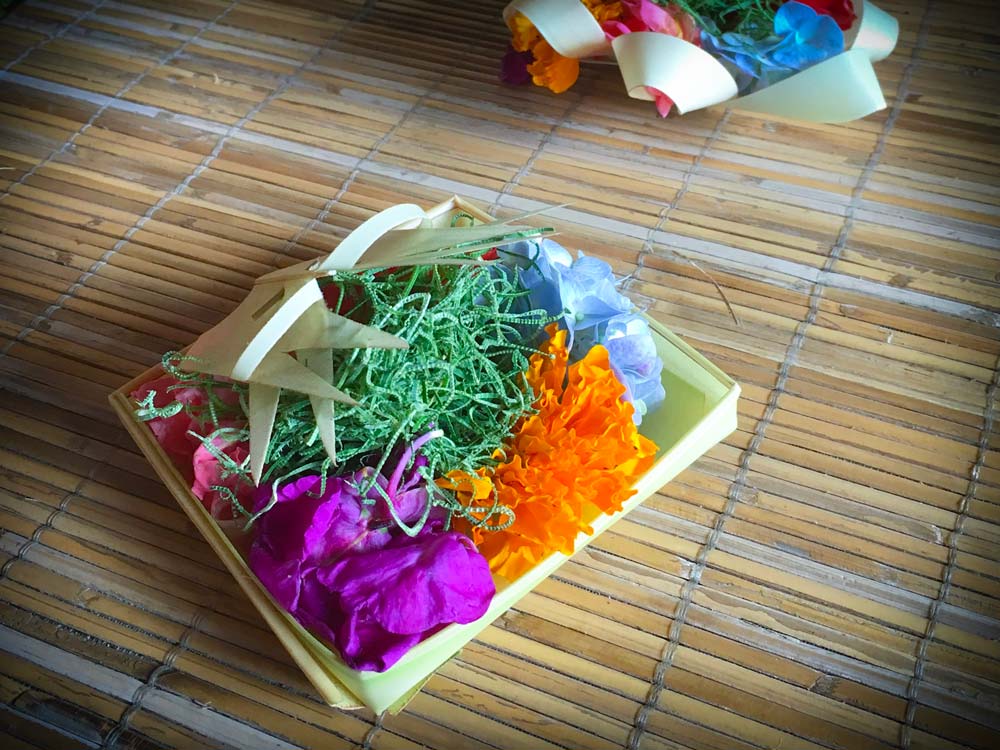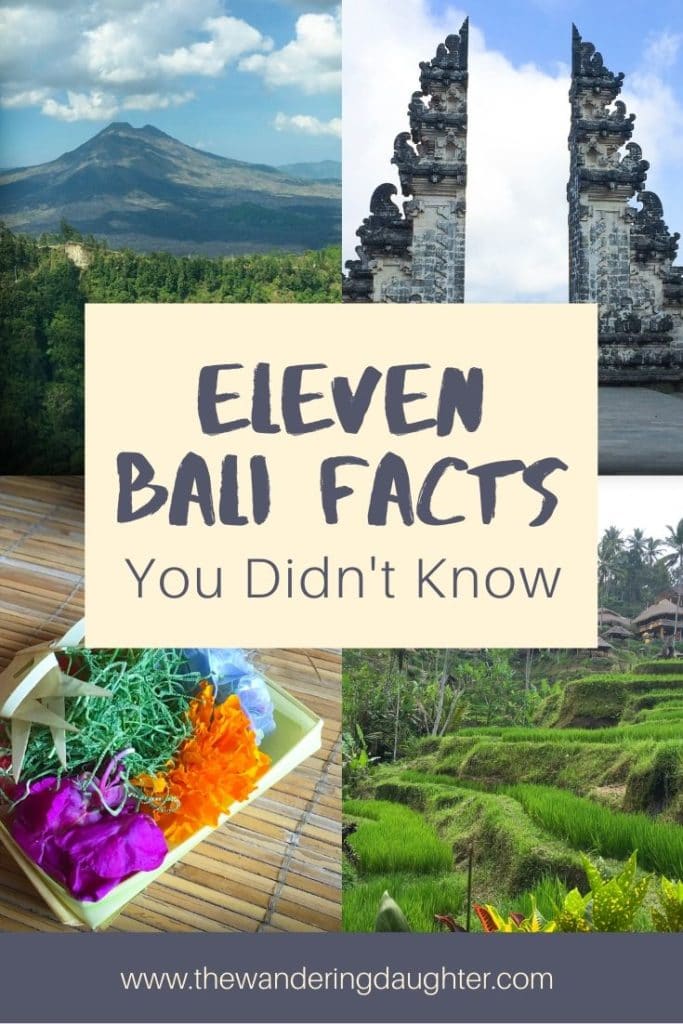11 Essential Bali Facts You Didn’t Know

One of the things I love doing when I visit the Indonesian island of Bali is learning as many Bali facts as I can. We’ve spent a considerable amount of time in Bali. During our travels through Bali, we've visited Kuta, Canggu, Sanur, Tabanan, Amed, Ubud, Gianyar, Denpasar, and Padang Bai.
I love learning about the island. There is so much about Balinese religion and Bali customs that are still so new to me! As a worldschooling family, we love learning about the places we visit. So all this Bali information we’ve acquired in during our travels has been so valuable to us!
Bali is a popular island to visit among travelers to Indonesia. And it’s not that hard to see why. Beautiful beaches surround the island. Snorkeling and diving are popular activities on the island. And the numerous volcanoes on the island make Bali’s land extremely fertile and green. You can certainly take your pick of activities during a Bali itinerary.
Yet, for all the attention that Bali gets among the traveling set, many visitors to Bali still don’t know that much about the culture. In my opinion, taking time to learn a few Bali facts will make your visit so much more enjoyable and meaningful!
This post was updated April 21, 2022.
This post may contain affiliate links. That means I may receive a small commission if you click on the link and purchase something. But don't worry, this will not result in any extra costs to you.

Practical Bali facts you need to know
Getting into the island of Bali is relatively easy. The main airport in Bali is Ngurah Rai International Airport. International flights arrive and depart every day from international airlines like Qantas, EVA, Singapore, Virgin Australia, and KLM. Local flights arriving from regional airlines like Air Asia, Garuda, Malaysia, and Jetstar also frequent the Bali airport.
In terms of practical Bali information, you'll have to factor in transportation into your Indonesia trip cost. Hiring a driver is a convenient option for families. Depending on where you are and where you are going, drivers can cost between Rp. 500,000-1,000,000 ($35-$70 USD) for a full day hire. Alternatively, you can choose to rent a car in Denpasar or at the airport for roughly the same price per day and drive yourself.
A more affordable, albeit more daring, option is to rent motor scooters for the day. The cost is roughly Rp. 50,000-70,000 per scooter per day. It is a convenient way to get around whatever city you’re in.
However, you need to understand the risks involved with driving a scooter, especially in cities with a lot of traffic. Make sure that you always get helmets for your children and you when you’re doing a scooter rental in Bali. And read up on more Bali facts regarding scooters from TripSavvy and Bali Holiday Secrets.
Dive deeper into exploring the island of Bali. Read up on my Bali post for ideas.

Taking time to know some Bali facts before you go
In 2018, the Bureau of Statistics in Bali reported roughly 5.95 million international visitors will visit Bali by the end of the year. This averages to around 495,000 international visitors per month.
Although the numbers have dropped significantly in 2020-2022 during the pandemic, I have no doubt that travel will pick up again as Indonesia opens up again.
Yet, for arrivals to Bali each year, a surprisingly small percentage of travelers know any kind of Bali facts other than it’s a great island for vacationing. I’m always surprised to learn how little some travelers know about Balinese religion and Bali customs, even if they’ve visited the island multiple times.
Worse yet, I often read or hear stories of tourists behaving badly in Balinese temples. Tourists have done disrespectful things in temples, sacred worshipping places for the Balinese, including having sex in a temple!
In my opinion, the best way to combat ill-behavior, is by spreading knowledge. Before you visit Bali, take time to learn some Bali facts. Brush up on some Bali information. That way, you come as an informed and responsible visitor, rather than an ignorant tourist.
The Bali, Lombok, and Nusa Tenggara guide book from Lonely Planet is a great starting off point for learning about Bali. If you’re interested in more in-depth Bali facts, my friend Katie from Katie’s Travel Tricks recommends Secrets of Bali: Fresh Light On The Morning Of The World.
For those of you considering a holiday to Bali, here are eleven Bali facts to know before you go.

1. Get your Bali facts straight: Bali is NOT a country!
Some people mistakenly believe Bali is its own country. A few years ago I read a blog post about the best countries for digital nomads that included Bali in the list. However, not once did the post mention the country that Bali is in Indonesia, despite every other country on that list being named. And earlier this year, I was at a travel conference when a tourism representative from one of the conference sponsors referred to Bali as a country.
To set the record straight, Bali is NOT a county. This is probably one of the most important Bali facts to know if you’re planning to visit. Bali is an island in the country of Indonesia.
For foreign visitors to Indonesia, a visa is required. In the past, travelers could get a visa on arrival for free at the airport, which grants a stay of up to 30 days. Alternatively, they could apply for a visit visa on arrival at the airport, which costs $35 USD, and can be extended for up to 60 days at a local immigration office. However, due to the pandemic, this is currently on hold.
For the moment, travelers must apply for a 30 day visit visa, which can be extended for an additional 30 days up to 4 times. You’ll need to apply ahead of time, and you will need someone to be your sponsor. There are private companies in Indonesia who can help you find a sponsor.

2. The Balinese people are a minority
The Indonesian archipelago consists of over 17,000 islands. Among those 17,000+ islands, 6,000 are inhabited. And within the 6,000 inhabited islands live over 300 individual ethnic groups.
The island of Bali is miniscule in comparison to many of the other islands of Indonesia, both geographically and ethnically. In fact, the Balinese people make up less than 2% of the population of Indonesia! Yet when most foreigners think of Indonesia, they automatically think of Bali.
If you’re putting together a plan to visit Bali with your family, build some days in your itinerary to visit some islands and cities outside of Bali, like the city of Yogyakarta on the island of Java. Get to know the remaining 98% of the Indonesian population!

3. Balinese names are similar
If you’re planning on visiting the island of Bali, you’ll come across some unique Bali customs during your visit. One custom you may encounter is the naming of children.
Within Balinese culture, a child’s name is assigned depending on their birth order. The names are the same regardless of whether the child is a girl or a boy. So sometimes an “I” is put in front to refer to boys, and a “Ni” is put in front to refer to girls.
First born children are named Wayan, Putu, or Gede. Second born children are named Made, Kadek, or Nengah. Third born children are named Nyoman or Komang. And fourth born children are named Ketut. Starting with the fifth child, the cycle starts over again.
This explains why so many Balinese names are similar. If my husband and I were Balinese, he would be Wayan, and I would be Made!

4. Balinese religion is unique
Compared to the rest of Indonesia, which is Muslim, the Balinese religion is Hindu. But it’s a different breed of Hinduism than what you might find in a country like India.
Balinese religion, like many of the other religions in other parts of Indonesia, is a mix of external religious influence with internal indigenous beliefs. When Hinduism came to Bali, it adapted itself to the existing Buddhist and animist beliefs.
What came out of this mix is a brand of Hinduism that is unique to the island of Bali, one that’s steeped in rituals and beliefs in the spirits of the world.

5. Balinese culture came from Java
One of the Bali facts that may come as a surprise is that Balinese religion and culture actually came from the neighboring island of Java, where Hinduism and Buddhism had existed since the first century BCE. When Islam spread throughout Indonesia in the 15th and 16th, Hinduism and Buddhism were pushed onto the island of Bali.
Today, the island of Java is predominantly Muslim, but remnants of the island’s Buddhist past remains in the sprawling Borobudur Temple near Yogyakarta. Java’s Hindu past lives on in the shadow puppet plays and traditional dancing. In Bali, Buddhism is no longer practiced.

6. Offerings are a big part of daily life
One of the Bali customs that makes Hinduism in Bali so unique are the offerings. Consisting of palm leaf containers filled with flowers, leaves, rice, these offerings, known as canang sari, are found everywhere throughout Bali. They are made every day, multiple times per day, and are meant to appease the spirits that inhabit our world.
Within Balinese tradition, these offerings are typically made by women. They can take hours to create since they have to make so many. It’s an example of some of the gender roles that exist within Balinese culture.

7. There are hundreds of temples in Bali
I read somewhere that there are more temples in Bali than there are homes! This may be one of those exaggerated Bali facts that you read on the internet, but it might not actually be too far from the truth. Besides public temples, known as pura, that can be found throughout the island, every traditional Balinese home also has its own family temple as well.
Some of the famous temples around Bali include Tanah Lot, Uluwatu, Lempuyang, and Besakih. Please be respectful of the Balinese religion when visiting a temple.
It’s part of Bali custom to wear a sarong when you enter a temple. And also be sure that you wear a top that covers your whole torso, including your shoulders and back. This applies to both men and women, as well as children.

8. Balinese locals live on $5-$35 USD per day
I was hit with some sticker shock when I came to Ubud. While everything here costs less than what they would cost in the United States or Europe, prices in this city are surprisingly high in comparison to what locals make. In fact, most Balinese can't afford to live in Ubud proper.
In Indonesia, each region sets their own minimum wage based on local factors like cost of living. For 2019, the minimum wage for the island Bali is roughly $161 USD per month (a little over $5 USD per day). In the regency of Gianyar, where the city of Ubud is located, the minimum wage is almost $170 USD per month (still less than $6 USD per day). For high paying local salaries, Balinese can earn around $1,050 USD per month or more.
This is one of the Bali facts that tourists need to understand when they come to the island: income disparity between the locals and expats is very real. Considering that a meal at a restaurant for our family of four has been averaging us around Rp. 200,000 (roughly $14 USD), it’s quite difficult for an average Balinese to achieve the same standard of living that tourists enjoy quite freely.

9. Pollution is a big problem
Another one of the sobering Bali facts that visitors may not want to hear is that pollution is a real problem in Bali. Plastic trash litter the streets, landscapes, and waters around Bali. Locals still burn their trash. And public recycling is virtually non-existent.
Additionally, a lot of the plastic in Indonesia doesn’t actually come from Indonesia. Instead, it’s imported by countries like the United States and European countries who outsource their recycling program. This influx of plastic overwhelms Indonesia’s recycling capabilities, and much of the excess plastic goes into trash piles or is burned.
Fortunately, there are several initiatives and organizations in place that are working to reverse the effects of pollution in Bali. Organizations like Eco Bali have set up private waste management collection services, and provide eco-training to businesses throughout the island. Trash Hero organizes beach cleanups to pick up trash on the beach. And the regional government recently issued a ban on plastic bags, straws, and Styrofoam back in July, which stores and restaurants are expected to follow.
All of these are steps to a cleaner and healthier Bali. You can help by traveling with eco-friendly travel products or aiming to reduce your reliance on single use plastic by bringing a reusable water bottle like the GRAYL.

10. Farming is still a big part of life in Bali
One of the realities of Bali is that farming is still very much a large part of everyday life. Rice is a staple in Balinese cuisine, so rice cultivation is quite important for Balinese families. This is evident in the iconic rice paddies and terraces that cover the island landscape.
While in Bali, we had a chance to learn about rice farming during a village tour that we did. It was a great educational experience for our worldschooling family!
While many farmers have sold their land for millions to big hotel chains and developers, some have remained on the land, working on plots of land that have been part of their family for generations. The terraces and rice paddies are fed water through a complex irrigation system called a subak, which pull from mountain springs throughout the island.
Temples sit at the source of many of these springs, welcoming visitors who come on a daily basis to purify themselves with the holy water from these temples. The subak acts as a type of cooperative, where farmers are allotted certain amounts of water for their fields.
I’m always in awe of how organized rice cultivation is in Indonesia. The community really does work together to grow the crops that will eventually feed them.

11. The best source for Bali facts are the Balinese
If you’re wanting to learn more Bali facts, the best source for this information is the Balinese themselves! The Balinese love to share about their culture and history with others, as well as their traditions and beliefs.
While you’re in Bali, take some time to ask a Balinese about their island. Find out something unique and interesting about Balinese culture. And make an effort to understand what life is like for the Balinese.
Want to travel respectfully and responsibly? Read my sustainable travel posts.

Seeking out your own Bali facts when you visit
As visitors to the island of Bali, we can’t possibly know all there is to know about Bali. The culture of Bali is complex, as are the social, environmental, and even political issues that the island faces.
But what we can do is seek out our own Bali facts. We can be responsible travelers, and make an effort to get to know Bali, beyond the beaches and the Instagram-worthy sights.
Have you had a chance to spend time in Bali? What are some Bali facts you’ve learned during your trip? Share them in the comments.

Need help thinking through how to budget for a family trip? My Travel Budget Worksheet is just the tool you need! Click here to receive your free copy by signing up for my newsletter.
Want to connect with me on social media? Find me on Facebook, Instagram, Pinterest, and Twitter. And for those of you who are dedicated to traveling more responsibly, sustainably, and ethically, join over 500 like-minded families on my Facebook group, Responsible Family Travel.






